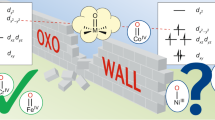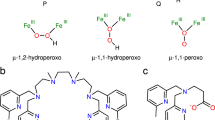Abstract
Critical biological electron-transfer processes involving high-valent oxometal chemistry occur widely, for example in haem proteins [oxoiron(IV); FeIV(O)] and in photosystem II. Photosystem II involves Ca2+ as well as high-valent oxomanganese cluster species. However, there is no example of an interaction between metal ions and oxoiron(IV) complexes. Here, we report new findings concerning the binding of the redox-inactive metal ions Ca2+ and Sc3+ to a non-haem oxoiron(IV) complex, [(TMC)FeIV(O)]2+ (TMC = 1,4,8,11-tetramethyl-1,4,8,11-tetraazacyclotetradecane). As determined by X-ray diffraction analysis, an oxo-Sc3+ interaction leads to a structural distortion of the oxoiron(IV) moiety. More importantly, this interaction facilitates a two-electron reduction by ferrocene, whereas only a one-electron reduction process occurs without the metal ions. This control of redox behaviour provides valuable mechanistic insights into oxometal redox chemistry, and suggests a possible key role that an auxiliary Lewis acid metal ion could play in nature, as in photosystem II.
This is a preview of subscription content, access via your institution
Access options
Subscribe to this journal
Receive 12 print issues and online access
$259.00 per year
only $21.58 per issue
Buy this article
- Purchase on Springer Link
- Instant access to full article PDF
Prices may be subject to local taxes which are calculated during checkout





Similar content being viewed by others
References
Kaim, W. & Schwederski, B. Bioinorganic Chemistry: Inorganic Elements in the Chemistry of Life (Wiley, 1994).
Kovacs, J. A. How iron activates O2 . Science 299, 1024–1025 (2009).
Ferguson-Miller, S. & Babcock, G. T. Heme/copper terminal oxidases. Chem. Rev. 96, 2889–2908 (1996).
Diner, B. A. & Babcock, G. T. Oxygenic Photosynthesis: The Light Reactions (Kluwer Academic Publishers, 1996).
Yagi, M. & Kaneko, M. Molecular catalysts for water oxidation. Chem. Rev. 101, 21–36 (2001).
McEvoy, J. P. & Brudvig, G. W. Water-splitting chemistry of photosystem II. Chem. Rev. 106, 4455–4483 (2006).
Ferreira, K. N. et al. Architecture of the photosynthetic oxygen-evolving center. Science 303, 1831–1838 (2004).
Loll, B. et al. Towards complete cofactor arrangement in the 3.0 Å resolution structure of photosystem II. Nature 438, 1040–1044 (2005).
Yano, J. et al. Where water is oxidized to dioxygen: structure of the photosynthetic Mn4Ca cluster. Science 314, 821–825 (2006).
Sporoviero, E. M. et al. Quantum mechanics/molecular mechanics study of the catalytic cycle of water splitting in photosystem II. J. Am. Chem. Soc. 130, 3428–3442 (2008).
Barber, J. Photosynthetic energy conversion: natural and artificial. Chem. Soc. Rev. 38, 185–196 (2009).
Que, L. Jr The road to non-heme oxoferryls and beyond. Acc. Chem. Res. 40, 493–500 (2007).
Nam, W. High-valent iron(IV)–oxo complexes of heme and non-heme ligands in oxygenation reactions. Acc. Chem. Res. 40, 522–531 (2007).
Sono, M., Roach, M. P., Coulter, E. D. & Dawson, J. H. Heme-containing oxygenases. Chem. Rev. 96, 2841–2887 (1996).
Meunier, B. (ed.) Metal-Oxo and Metal-Peroxo Species in Catalytic Oxidations (Springer-Verlag, 2000).
Ortiz de Montellano, P. R. (ed.) Cytochrome P450: Structure, Mechanism, and Biochemistry (Kluwer Acaemic/Plenum Publishers, 2005).
Fukuzumi, S. Roles of metal ions in controlling bioinspired electron-transfer systems. Metal ion-coupled electron transfer. Prog. Inorg. Chem. 56, 49–153 (2009).
Fukuzumi, S. Catalysis on electron transfer and the mechanistic insight into redox reactions. Bull. Chem. Soc. Jpn 70, 1–28 (1997).
Fukuzumi, S. New perspective of electron transfer chemistry. Org. Biomol. Chem. 1, 609–620 (2003).
Rohde, J.-U. et al. Crystallographic and spectroscopic characterization of a nonheme Fe(IV)=O complex. Science 299, 1037–1039 (2003).
Lee, Y.-M. et al. Fundamental electron-transfer properties of non-heme oxoiron(IV) complexes. J. Am. Chem. Soc. 130, 434–435 (2008).
Fukuzumi, S. & Ohkubo, K. Quantitative evaluation of Lewis acidity of metal ions derived from the g-values of ESR spectra of superoxide–metal ion complexes in relation with the promoting effects in electron transfer reactions. Chem. Eur. J. 6, 4532–4535 (2000).
Fukuzumi, S. & Ohkubo, K. Fluorescence maxima of 10-methylacridone–metal ion salt complexes: a convenient and quantitative measure of Lewis acidity of metal ion salts. J. Am. Chem. Soc. 124, 10270–10271 (2002).
Bukowski, M. R. et al. A thiolate-ligated nonheme oxoiron(IV) complex relevant to cytochrome P450. Science 310, 1000–1002 (2005).
Thibon, A. et al. Proton- and reductant-assisted dioxygen activation by a nonheme iron(II) complex to form an oxoiron(IV) intermediate. Angew. Chem. Int. Ed. 47, 7064–7067 (2008).
Ray, K. et al. An inverted and more oxidizing isomer of [FeIV(O)(tmc)(NCCH3)]2+. Angew. Chem. Int. Ed. 47, 8068–8071 (2008).
Acknowledgements
This work was supported by a Grant-in-Aid (no. 20108010 to S.F.) and a Global COE program, ‘the Global Education and Research Center for Bio-Environmental Chemistry’ from the Ministry of Education, Culture, Sports, Science and Technology, Japan (to S.F.), and NRF/MEST through a WCU project (R31-2008-000-10010-0) (to S.F. and W.N.) and the Creative Research Initiatives Program (to W.N.). Crystallographic data for [(TMC)FeIV(O)–Sc(OTf)4(OH)] have been deposited with the Cambridge Crystallographic Data Center under reference numbers CCDC-742067 (X-ray).
Author information
Authors and Affiliations
Contributions
S.F., Y.M., H.K. and W.N. conceived and designed the experiments. Y.M. and P.N. performed the experiments. Y.M., H.K. and P.N. analysed the data. P.N. and Y.M.L. contributed materials and analysis tools. S.F. and W.N. co-wrote the paper.
Corresponding authors
Ethics declarations
Competing interests
The authors declare no competing financial interests.
Supplementary information
Supplementary information
Supplementary information (PDF 1206 kb)
Supplementary information
Crystallographic data for the non-heme oxoiron(IV) complex (CIF 24 kb)
Rights and permissions
About this article
Cite this article
Fukuzumi, S., Morimoto, Y., Kotani, H. et al. Crystal structure of a metal ion-bound oxoiron(IV) complex and implications for biological electron transfer. Nature Chem 2, 756–759 (2010). https://doi.org/10.1038/nchem.731
Received:
Accepted:
Published:
Issue Date:
DOI: https://doi.org/10.1038/nchem.731
This article is cited by
-
Crown-hydroxylamines are pH-dependent chelating N,O-ligands with a potential for aerobic oxidation catalysis
Nature Communications (2023)
-
Electronic structures, bonding, and spin state energetics of biomimetic mononuclear and bridged dinuclear iron complexes: a computational examination
Structural Chemistry (2021)
-
Iron and manganese oxo complexes, oxo wall and beyond
Nature Reviews Chemistry (2020)
-
Ion association with tetra-n-alkylammonium cations stabilizes higher-oxidation-state neptunium dioxocations
Nature Communications (2019)
-
Mono- and binuclear non-heme iron chemistry from a theoretical perspective
JBIC Journal of Biological Inorganic Chemistry (2016)



